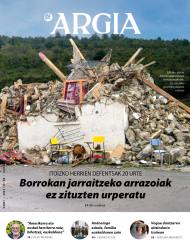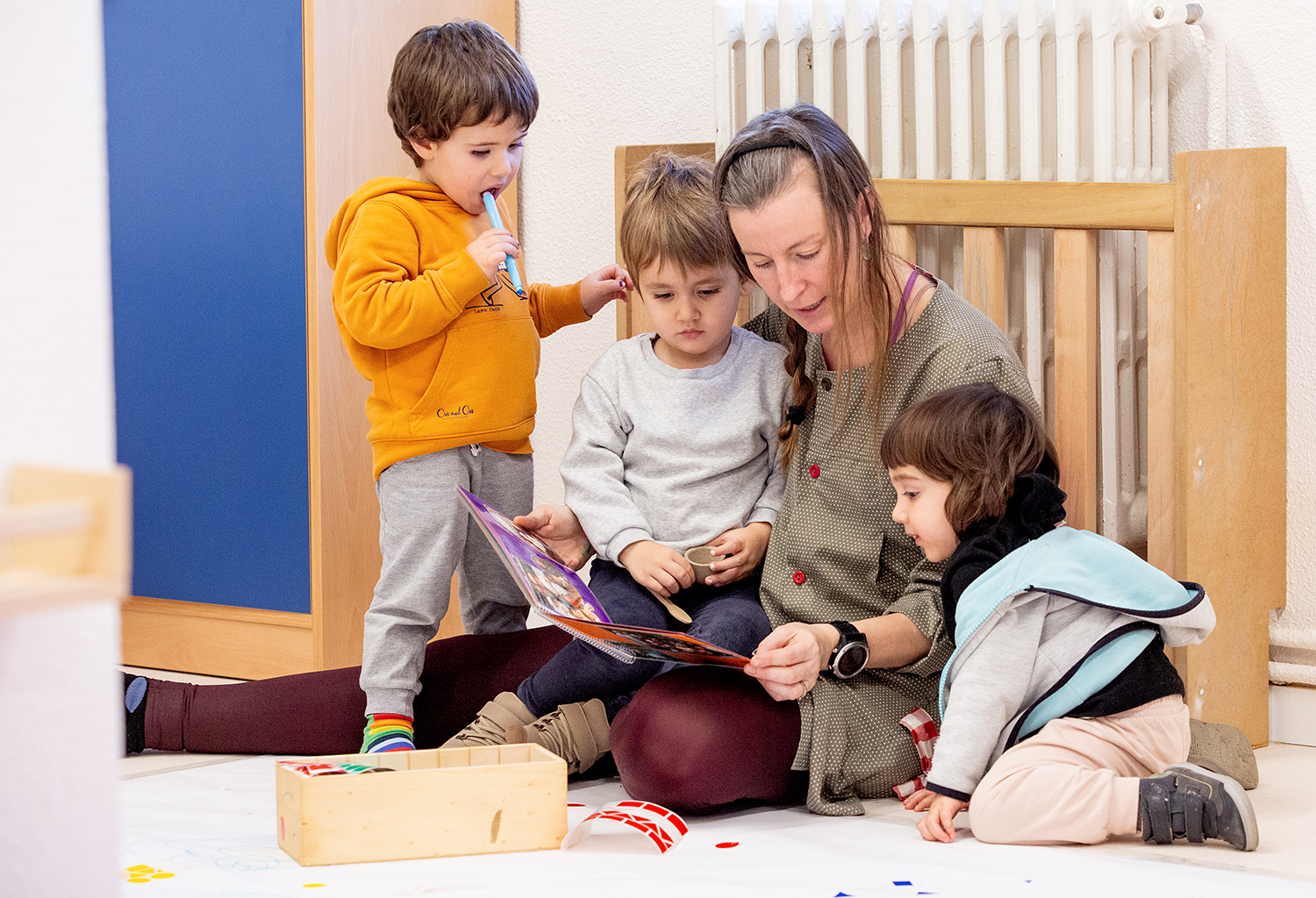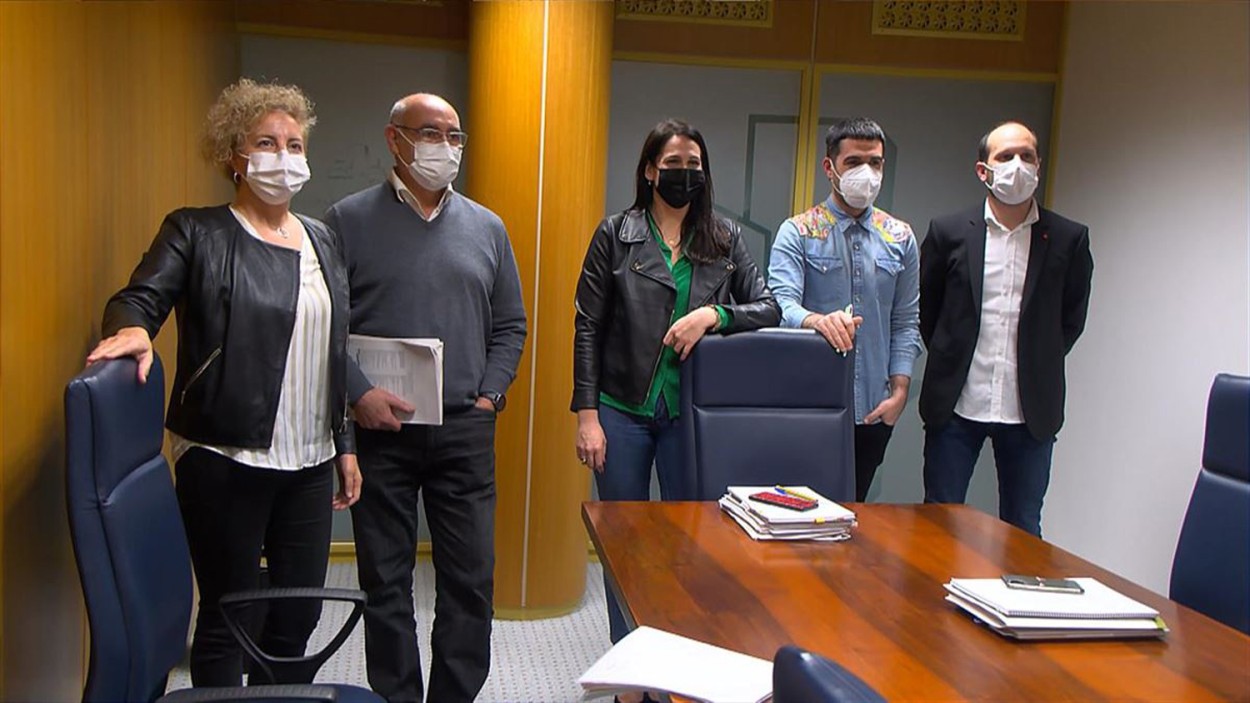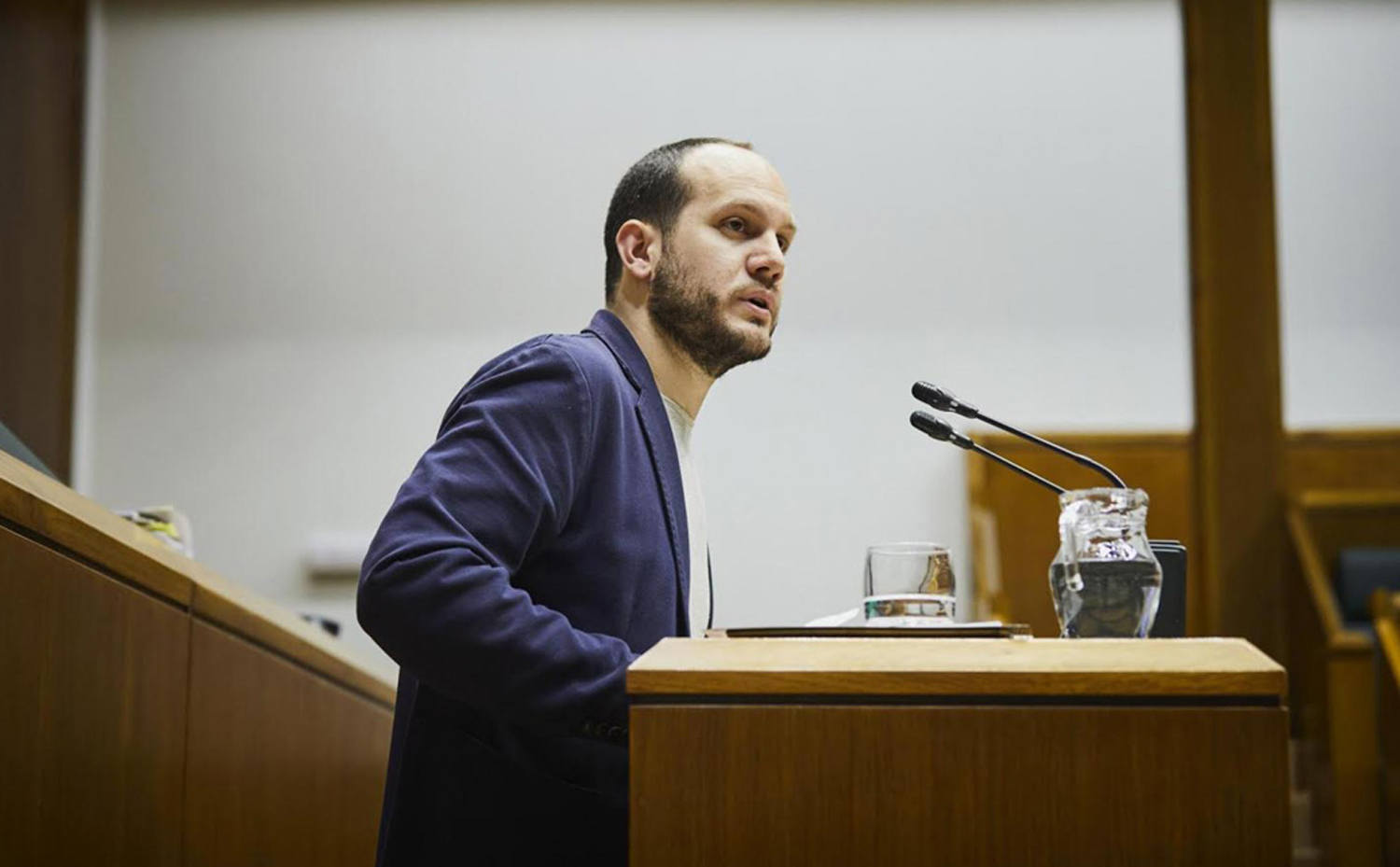"Give local school a chance."
- Do you know Ondarreta Herri Eskola de Andoain? What's in the center of town? If you cross the entrance door with me, you are in the patio with the 201 students of this public school that add 24 origins and 17 languages. We will enter the corridors of the registration decree that the Government has just launched to deal with segregation; we will arrive at one of those rooms with walls as white as the words of the administration, where we can sit quietly in the chairs that have left the Basque children empty. Come on. Its members are willing to talk about this "local problem".

We are already ghettos,” said Father Henar Arranz. She is the daughter of Spanish migrants, born in Andoain and studied at ikastola, and currently brings her children to the Ondarreta public school. Director Maite Petrikorena explains the situation as follows: "Enrollment is falling due to the low birth rate, but in the case of Ondarreta it is added to this problem that we have very few students who are Basque at home and who, on the contrary, are accumulating all students who are children of migrants". Arranz follows: "We need Basque children for real integration. Our children are very integrated, but the rest of the people are not." Petrikorena stressed that integration is a local issue: "This is not a Ondarreta problem, it's a Andoain problem. And we put it on the table, not only in Education, but also in the people. We alone can't."
Ondarreta in data
- It's an empty D-Model public school.
- Early childhood and primary education (2-12 years).
- Total pupils: 201. In Andoain there were 1,430 students enrolled in 2021-2022 (data: Eustat).
- 2 year students: 87 children enrolled in the locality during the course 2023-2024, 9 of them in Ondarreta.
- Diversity: There are students from 24 countries in Ondarreta and 17 languages are spoken among them.
"First know all classes and then choose"
This year 87 2-year-old boys and girls have enrolled in Andoain, of whom only 9 have enrolled in Ondarreta. Why do Basque parents not register their children in Ondarreta? Lorena Cabezas puts the word "stigma" on the table. He is the father of Ondarreta and daughter of Spanish migrants. She studied in Ondarreta, in model B, and currently at home speaks at home in Basque with her daughter and her husband. In the words of Cabezas, "this school is always very stigmatized. In my day we were here children of Castilian parasites and now they come from other countries."
At the time of enrollment of this course, only three families who were no longer parents of Ondarreta have approached in search of information. For director Petrikorena "we don't exist. It seems that in the village there are only two options to register, or the Christian school or the ikastola." Arranze knows this from the experience: "Have you asked me on the street, if there's another school? ". This ignorance of the school, which is located in the middle town, is surprising: Next to the Bastero Cultural Center is the Herri Eskola with a beautiful covered patio where the children of all schools play in the afternoon.
Arranze invites all Andoain parents to give the local school a chance to know at least: "I had not considered Ondarreta at first. The children went to kindergarten and there I met Cabezas and he asked us why not look at Ondarreta? '. We set out to give an opportunity, go open doors and then decide. I think the least is that, to take it into account as an opportunity when collecting the information and then making the decision."
The pedagogical model of Ondarreta was known at the open doors and was the reason his children enrolled in it: "We thought that at least Early Childhood Education would be done in it, and then there was an opportunity that if we weren't comfortable Primary Education would be done in another center. We test it and we are satisfied, the children are already in elementary school." Director Petrikorena stresses that the educational project is one of Ondarreta’s strengths: "We have the Amara Berri system. Outside here it has a great reputation and prestige, and here many people don't know we have it."
.jpg)
For the Basque Country
In 2019 Ondarreta is 50 years old. He is currently named "Herri Eskola" to claim his popular character. Petronor has given a historical vision: "I have been in this school for 19 years and I have seen evolution perfectly. In the past, there were models B and D, and the Basque people came to model D, both from Andoain and from neighboring towns, while those who did not know Euskera went to model B. Around 2004 we decided not to have model B to promote the Basque Country and that all the students go along the same line, and when we put them all together in model D, then the descent of the Basque children began. Since then, the concerted centres have gained great strength: the Christian school is twice that of Ondarreta and the triple ikastola. Many people in Andoain think that if they do not go to the ikastola they will not learn Basque. They still ask me if this is done in Basque. We have been in an empty D model for 20 years, it is time to dispense with false beliefs! ".
Is the Basque Country safe studying in Ondarreta? “Yes, of course,” Petronor confirmed. "I am the example," adds Cabezas. Petrikorena has spoken from her own experience: "We learn a language when we need it. My parents came from Navarra and my father knows how to speak Basque, but very little has been done in my house because the mother does not know. I also studied in Spanish. When I was going to do teaching, I decided to do it in Basque. I'm a vasophile. At Ondarreta we teach all the studies in Basque, and of course you learn Basque, but the use is bad. Why? Because they don't need Basque outside school, for them it's the third or fourth language. At home they use another language, neither Spanish nor Basque". Arranz follows: "For the children of this school we lack an Euskaldun environment that encourages the need to do so in Euskera. We cannot create it if Basque children do not come from home." That is why the Basque people in Andoain have been approached: "The true militancy with the Basque is right now in school. Anyone who wants to spread the Basque country must do so to those who do not know, and those who do not know are here. Here we have to create love for the Basque. I would ask them to give way to the Basque parents, to show that militancy, because we need it."
Right to choose vs integration?
The government's new enrollment system qualifies students as "vulnerable" and "non-vulnerable" and each area of influence, in this case the town of Andoain, has a rate of "vulnerable". In this way it is intended to tackle segregation, but at Ondarreta College they have known the contradictions of the new system. As Petronor explained, "with the number of "vulnerable" we have, we spend a lot of time in that proportion and, in principle, among those who register late, we can only take "non-vulnerable", which do not surround us". Secretary Truchuelo explains that during this course three families have been registered out of time, "but they are not "vulnerable", and in Ondarreta they had to register, but they complained in Education and have not started here".
To Petronor's, it seems very good that the "vulnerable" students are divided among the centers, "but not only must they be separated, but also the others". Arranz poses the dilemma: "Give priority to the right to choose families to the welfare of society."
Fewer and fewer students are born. The chairs and units occupied in the schools will be emptied. Therefore, they explain that the key to the theme is the number of lines each center has. Arranze question: "Depending on what lines does the government divide? Depending on the right of parents to decide? If the Administration has a public school service in Andoain, why not strengthen it? ". Petrikorena considers that the division of government lines has had a major influence on the decline of Ondarreta: "15-16 years ago we had two lines and had space to accommodate more students, but the Education allowed at that time to open the third line in the two concerted centers of Andoain. We said then that it would be our end, and so it has been. Here's an easy place to form two lines. We still have two lines at some levels, but we're becoming a line."
Vulnerable or rich?
Truchuelo rages the word "vulnerable": "I register and now I have to pass a questionnaire to all families and when the answer goes into the computer the app classifies whether the student is "vulnerable" or "not vulnerable". We're empty numbers." He has denounced that the questions are "very materialistic" and that asking these questions is "very violent": "You wonder if they have Netflix, how many rooms they have at home and how many books... How many books will the newcomer have? ". Some families ask why the center wants to know all this. "What should I answer? 'Do I want to know if you're vulnerable or not? '. And the next question is, "What is that?" We don't think it's right to do it," says Truchuelo.
Despite the label "vulnerable", isn't a group of students of 24 origins and 17 languages culturally rich? Petronor: "Of course our school is very rich, it is a pleasure to know how many things are learned in daily practice, which are not heard anywhere. The basis is to know us. Diversity is a treasure, but it must be managed."
According to Arranz, "in the people it is not valued that this is wealth. Our children are very rich, parents too, but we need to bring more Basque children home." In Andoain there is a program for the families of Andoain to get in touch with the newcomers, called Ongi Etorri, but Arranz emphasizes that in Ondarreta they live daily, without the need for special programs: "If I am late to pick up the child, I will call anyone at the door, I do not care if he is Moroccan, Ukrainian or Ivory Coast. And vice versa. That's the coexistence." Leire Uralde is the head of studies and thinks the same thing about "interculturality": "In Ondarreta, that's everyday, it's not a subject to be discussed in class or a day to celebrate, but the one we live every day."
.jpg)
Solutions
Its members are in danger of jeopardising Ondarreta’s future and say that to reverse the situation they need the help of all the actors. Cabezas proposes the following concrete measures for the solution: "The City Hall should conduct a local marketing campaign in favor of the public school so that the parents of the people get closer. The City Hall can send a letter to families with children of 2 years old, informing of all the school possibilities existing in the city". Arranz adds: "Haurreskola can also bridge, channel parents who are there at the open doors of local public school."
They ask that the education department "allocate all license plates and equip the lines of study". Petronor: "The Department of Education advocates that 50% of the network be public and 50% concerted. This distribution, theoretically, is very simple in Andoain, with Ondarreta two lines and the other two concerted centres one line." Arranz follows: "Because we are a public service, we need protection. Both from Education and from the City Hall. We'd like to be cared for and even pampered."
Since the 1980s, the City Council has channeled its relationship with each of the local schools through an agreement, allocating to each one an economic item based on their number of students. So far Ondarreta has had to face the maintenance of the building from that convention money, but the members of the public school do not agree with that mode of operation. Petronor: "We do not need an agreement, what the city council should do is ensure that the public school is maintained without the agreement. The building is Education but the City Hall is responsible for the maintenance".
We went out to the patio of the school located in the center of Andoain to take pictures. All kinds of children play and have surrounded us with curiosities, in Basque. Starter: "The patio is municipal, but it is open to the people, so why do we have to pay from the departure of the "convention" of Ondarreta its maintenance? ". Truchuelo is satisfied by the use of the school patio as an infrastructure of the municipality: "When it rains, local initiatives are made, at any time, because it's always open." "Although all Andoain schools receive municipal public money, Ondarreta's is the only school playground that is always open," Arranze says. The patio is full of village children in the evenings. The members of Ondarreta, full of boys and girls of all kinds of people, would like to see this also during school hours.





















